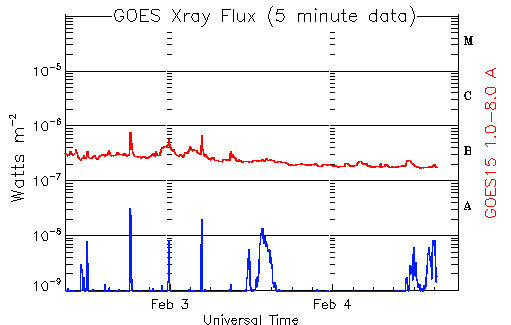SLIGHT CHANCE OF AURORAS: NOAA forecasters estimate a 15% chance of geomagnetic activity around the Arctic Circle today in response to an incoming solar wind stream. High latitude sky watchers should be alert for auroras mixed with waxing-full moonlight. Aurora alerts: text, voice.
FLAT-LINED: With none of the sunspots on tthe Earthside of the sun actively flaring, the sun's X-ray output has flatlined, as shown in these data from NOAA's GOES15 satellite:
Solar activity is expected to remain very low throughout the weekend. NOAA forecasters estimate no more than a 1% chance of M-class flares during the next 24 hours. Solar flare alerts: text, voice.
COMET-CLUSTER CLOSE ENCOUNTER: On February 3rd, Comet Garradd (C/2009 P1) sailed just 0.5 degrees from globular cluster M92 in Hercules. Italian astronomer Rolando Ligustri photographed the encounter using a remotely-controlled 106 mm telescope in New Mexico:
The full-sized image shows the comet's fan-shaped dust tail, which roughly traces the comet's orbit, and its pencil-thin gas tail, which points almost directly away from the sun due to the action of the solar wind.
Although the comet is now receding from the cluster, observers with wide-field telescopes can frame the pair in a single exposure for several mornings to come. They are located in the constellation Hercules, high overhead in northern hemisphere skies before sunrise. Sky and Telescope offers a sky map of the comet's path. Observers with computerized GOTO telescopes can track the comet by plugging in orbital elements from the Minor Planet Center.
At the moment, Comet Garradd has an astronomical magnitude of +6.5, invisible to the naked eye but an easy target for backyard telescopes. Forecasters expect it to brighten by a factor of ~2 in the weeks ahead as the comet approaches Earth for a 1.3 AU close encounter in early March. This could be a good time to invest in a Comet Hunter.
more images: from Ernesto Guido, Giovanni Sostero & Nick Howes using a remote-controlled telescope in New Mexico; from Paul Mortfield of Sierra Remote Observatories, California; from Gregg Ruppel of Ellisville, MO; from Alan C Tough of Elgin, Moray, Scotland; from Jean Jacquinot of Aix en Provence, France; from Gary Meehan of Sacramento Mountains, New Mexico; from Michael Kunze of Moers, Germany; from Dave Eagle of Higham Ferrers, UK;

![]()
Solar wind
speed: 441.2 km/sec
density: 3.4 protons/cm3
explanation | more data
Updated: Today at 1556 UT
![]()
X-ray Solar Flares
6-hr max: B2 1119 UT Feb04
24-hr: B2 0408 UT Feb04
explanation | more data
Updated: Today at: 1500 UT
![]()
![]()
![]()
Daily Sun: 04 Feb 12
![]()
![]()
All of the sunspots on the Earthside of the sun are quiet. Credit: SDO/HMI
![]()
![]()
![]()
Sunspot number: 39
What is the sunspot number?
Updated 02 Feb 2012
Spotless Days
Current Stretch: 0 days
2012 total: 0 days (0%)
2011 total: 2 days (<1%)
2010 total: 51 days (14%)
2009 total: 260 days (71%)
Since 2004: 821 days
Typical Solar Min: 486 days
Updated 02 Feb 2012
The Radio Sun
10.7 cm flux: 118 sfu
explanation | more data
Updated 02 Feb 2012
![]()
![]()
![]()
Current Auroral Oval:
![]()
Switch to: Europe, USA, New Zealand, Antarctica
Credit: NOAA/POES
![]()
![]()
![]()
Planetary K-index
Now: Kp= 2 quiet
24-hr max: Kp= 2 quiet
explanation | more data
![]()
Interplanetary Mag. Field
Btotal: 4.7 nT
Bz: 3.9 nT south
explanation | more data
Updated: Today at 1558 UT
![]()
![]()
![]()
Coronal Holes: 03 Feb 12
![]()
![]()
Solar wind flowing from the indicated coronal hole could reach Earth on Feb. 3-4. Credit: SDO/AIA.






